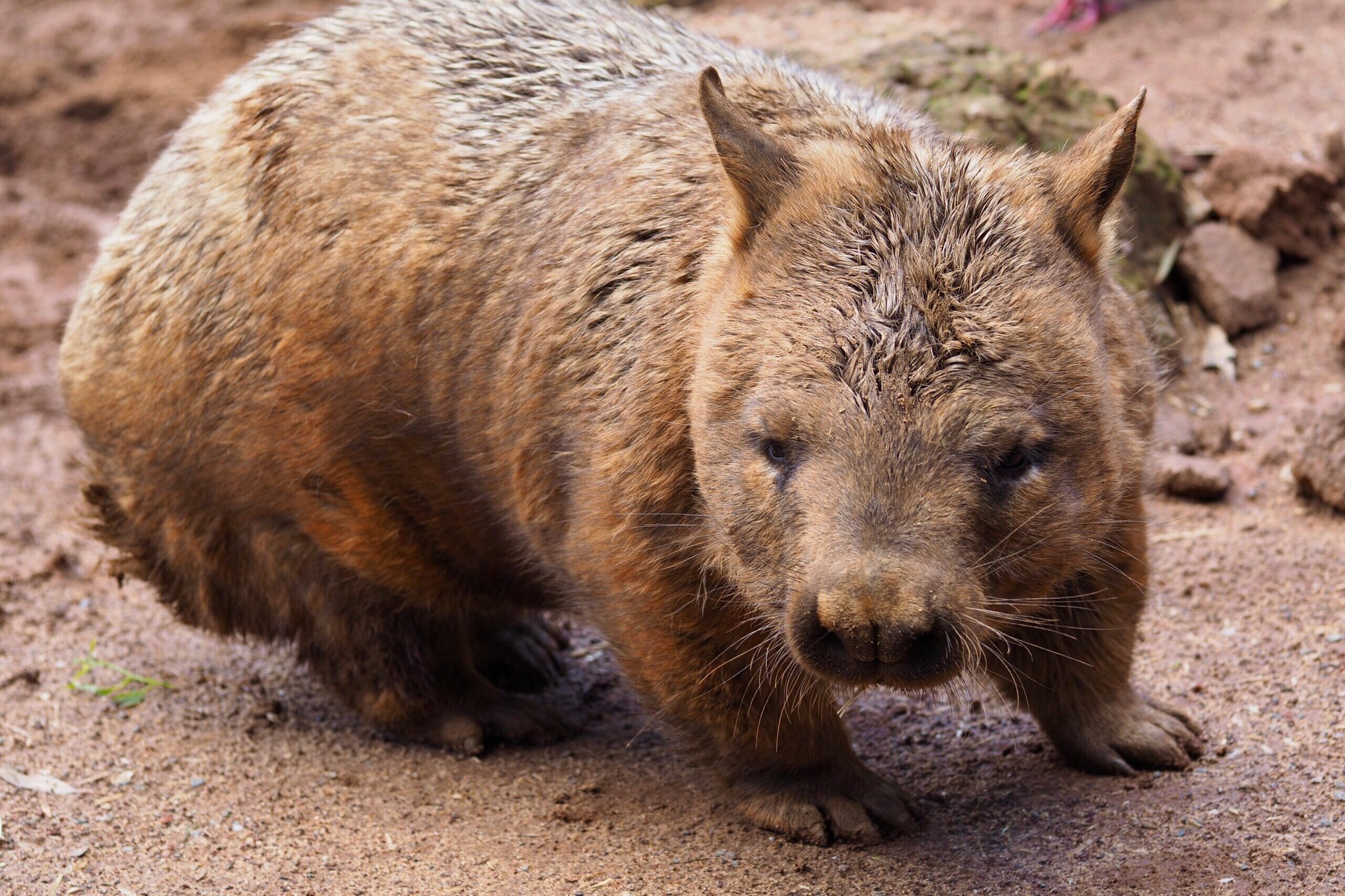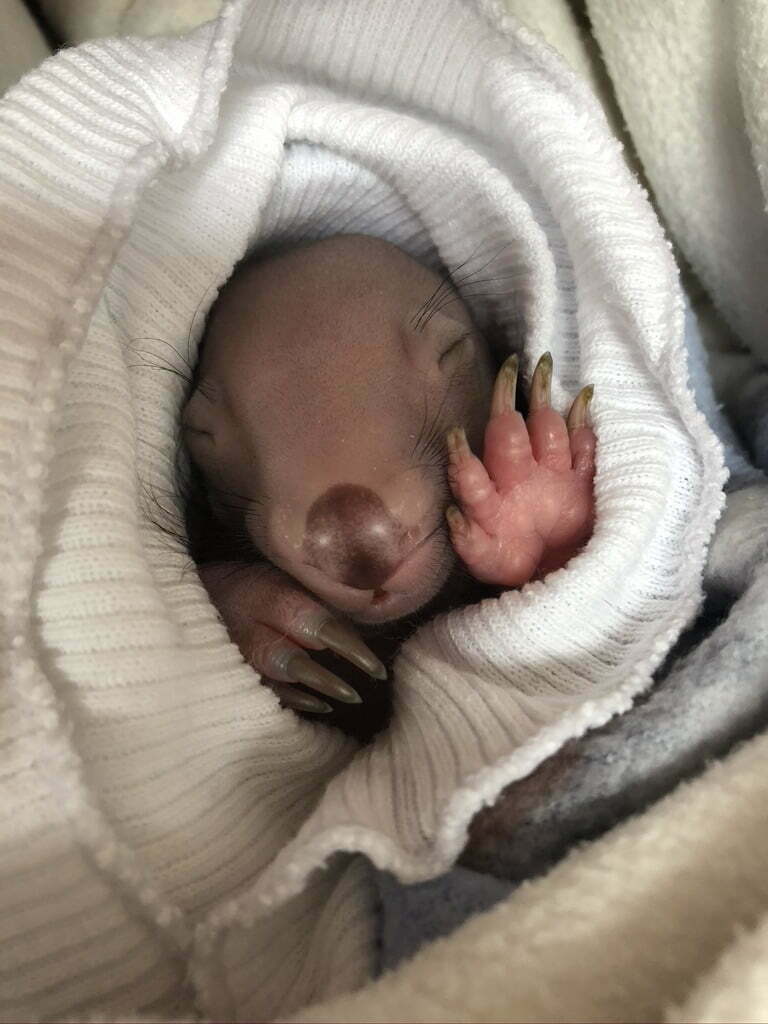RIPARIAN REAL ESTATE FOR WILDLIFE:
Guide: Wombat behaviour, burrows and being neighbours
By Kate McKenna, Lori Gould and Siwan Lovett
Wombats are one of our iconic native animals that find riverbanks particularly enticing. Although it is tempting to see the ‘damage’ they do building their houses in the banks of creeks and rivers, it is also important to appreciate the fact that they are one of the few native animals that have adapted well to the changes we humans have made to the landscape that was once their home. In fact, not only are they survivors, but they are very charismatic neighbours if we are willing to accept some of their habits.

As the gallery of photos below shows, wombats build extensive burrows in all parts of the landscpe. When they choose riverbanks, the erosion they cause is generally localised, and the impact of their activities relatively minor in the context of the whole waterway. A great deal more erosion is caused by a lack of groundcover, clearing of vegetation, stock trampling and changes to water flow as a result of these activities. Ensuring good ground cover and riparian vegetation along waterways through fencing from stock and revegetation (if necessary), will ameliorate most wombat impacts because they tend to keep themselves to specific areas.
Wombats inhabit a variety of habitats – forests, alpine, heathlands and coastal shrublands.

The Northern Hairy-nosed Wombat once had a broad range across the three eastern mainland Australian states. It’s now critically endangered, restricted to only two sites in Queensland and is considered one of the rarest mammals in the world. (Photo credit: Queensland Government Department of Environment and Science)

The Southern Hairy-nosed Wombat is considered Near Threatened and its population is highly fragmented and declining across semi-arid parts of South Australia, with just a few records in Western Australia and NSW.

The Bare-nosed or Common Wombat, once widespread throughout southern Australia, is now found in parts of eastern NSW, Victoria, south-eastern South Australia and Tasmania. The name implies there are a lot around but in truth they’re in decline, although they’re listed by the IUCN as a species of Least Concern.
The common wombat (Vombatus ursinus) is solitary, and nocturnal in nature. Its preferred habitat is wet, forested areas with slopes (for good burrow drainage) with a good source of grass, shrubs, roots, bark, and moss. All three wombat species eat a variety of variety of grasses, sedges, forbs, roots, and bulbs with their preference being for native grasses. Wombats may sometimes use the same feed sources as domestic stock, but they are solitary animals and their preference is for native grasses so, generally, their grazing impacts are minimal.
An important fact to note is that wombats are territorial animals. They mark their home range by grunting at intruders, rubbing their scent on trees, and scattering cube-shaped droppings, including the creation of soils on elevated surfaces. The unique shape of their dung helps keep the markings in place around their territory.
They may have up to twelve burrows in a home range, with three to four main burrows. A main burrow will house a network of sub-tunnels, that include multiple entrances and sleeping quarters. Most of the time wombats remain in their burrows to stay out of the heat and then venture out at night. This means that in most cases, an active burrow (or system of burrows) will be home to a sleeping wombat. It is safest to make this assumption when undertaking activities that may impact on them.
Mating generally occurs on a seasonal basis and is in relation to their location of their territory and associated conditions. Like all marsupials, babies develop inside their mother’s pouches for six-eight months, and are not fully mature until they are two years old. In the wild wombats have a lifespan of around fifteen years (but can live up to thirty years in captivity).
Above excerpt from Abi Cushman Animal Fact Guide 2019



Threats include destruction of habitat, competition with rabbits and livestock, poison, hunting, and road accidents. Foxes also spread deadly diseases to wombats such as mange. They are sometimes at ‘war’ with landholders when their burrows cause erosion in creek banks, or when they burrow into dam walls and under buildings. Fortunately, as this guide shows, there are some options for managing wombats in areas where they are not wanted or are in danger.
Mange is one of the biggest killers of wombats. The mange mite buries itself under the wombat’s skin triggering extreme itchiness which makes the wombat scratch, causing open wounds and scabs to form. These become infected, the wombat loses condition, becomes dehydrated, malnourished and slowly dies. The good news is, it can be treated – we have provided a link here to the Wombat Protection Society’s Mange and Disease page if you want to learn more about how to identify mange and what to do if you come across a wombat with mange.

Once established, Wombats are notoriously difficult to discourage or remove. This is largely because they are territorial and there is a hierarchy of dominance. The bigger stronger wombats colonise the best sites, which pushes smaller weaker animals out to less desirable areas. It is not unusual to find a concentration of large active burrows in the soft sandy soils along creek banks and flood plains, with a smaller number of burrows further afield in the less desirable soil which are smaller with fewer entrances.
This behaviour characteristic also makes it difficult to estimate wombat numbers, which means counting burrow numbers is extremely unreliable unless you have remote cameras, hair traps and other survey tools. One wombat may have six or more burrows, and some burrows have one or two entrances. A single wombat may also ‘own’ a generational burrow that over the years has been added to by other wombats. Wombats also have a wide home range – five hectares in good conditions, and up to 23 hectares in poor conditions – they can range as far as three kilometres in a single night (Abi Cushman 2019).
If there is a specific need to remove a Wombat from a particular area (e.g. a farm dam wall) there are some ways in which this can be done which minimises impacts on the animals.
Burrows can be fitted with a one-way sturdy ‘door’ or ‘gate’ which allows wombats to leave but not return. Hard steel mesh or more flexible hinge joint fencing can be attached to a post so that it hinges, and is buried deep into the top of a burrow, allowing the mesh to hang down and cover the entrance of the burrow from the outside. The wombat can push out by lifting the mesh (which closes behind it) but cannot push it back the other way. There are no specific designs for this, as most of the published designs are for wombat gates in fences, however, as long as the principle is adhered to, the outcome should be just as effective.
The photo below illustrate the design of wombat gates. The key to the design is to ensure that the mesh (whether it be hard mesh or flexible chicken wire) is firmly secured to the top of the burrow so that the wombat can push out through it and not get back in. Not harming the animal is a priority.

The photo on the left shows flexible hinge joint mesh secured so that a wombat can push through (in this case) a fence, but cannot get back in. The mesh needs to be secured so that it hinges up and the wombat does not remove it altogether. The photo on the right shows a hard, hinged steel mesh which can be secured over a burrow using steel posts – it is designed to be pushed out, but too large to swing back in and preventing the wombat from returning. These photos illustrate the concept – we could not find a formally designed burrow cover in the literature.
Prior to any disturbance of wombat burrows, they should be thoroughly checked for signs of activity – fresh scats, tracks, strong odour and/or signs of digging (as well as disturbance to burrow gates). If there is fresh activity, ensure that burrow gates are in place and avoid disturbing the burrow. If the presence of a wombat is unclear, and a burrow does need to be removed, it should be dug by hand (not machinery) until it is confirmed to be empty.
Removal and relocation of wombats should be a last resort as it is extremely difficult to achieve and legislation is in place to protect the animal. When a wombat is moved into a new area they face the challange of bigger dominant wombats who will often kill or harass them. In the case where an animal does need to be removed, you need to check the relevant government agency in your State or Territory.
In the event that a wombat is injured, call a local wildlife rescue service for assistance. It is recommended that contact is made with an expert widlife volunteer group prior to any planned excavation of burrows so that carers can be prepared if the wombat is injured. If all due care is taken and burrows are checked and monitored prior to works, this is unlikely to happen, but as noted previously, the behaviour of these animals can be unpredictable.
Guide prepared by Kate McKenna, Lori Gould & Siwan Lovett